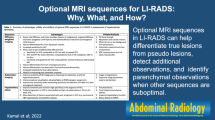Abstract
Liver magnetic resonance imaging (MRI) is a commonly performed imaging technique with multiple indications and applications. There are two general groups of contrast agents used when imaging the liver, extracellular contrast agents (ECA) and hepatobiliary agents (HBA), each of which has its own advantages and limitations. Liver MRI with ECA provides excellent information on abdominal vasculature and better quality multi-phasic studies for characterization of focal liver lesions. HBA improves lesion detection, provides information regarding liver function and can be helpful for evaluating biliary tree anatomy, excretion, anastomotic stenoses, or leaks. Most liver MRI studies are usually performed with one agent, however in some cases, a second study is performed with another agent to obtain additional information or confirm the findings in the first study. Administering both agents in a single exam can potentially eliminate the need for additional imaging in certain situations. In this pictorial review, the techniques and indications for dual contrast MRI will be detailed with multiple demonstrative examples.














Similar content being viewed by others
References
Davenport, M.S., et al., Comparison of acute transient dyspnea after intravenous administration of gadoxetate disodium and gadobenate dimeglumine: effect on arterial phase image quality. Radiology, 2013. 266(2): p. 452-61.
Motosugi, U., et al., An Investigation of Transient Severe Motion Related to Gadoxetic Acid-enhanced MR Imaging. Radiology, 2016. 279(1): p. 93-102.
Pietryga, J.A., et al., Respiratory motion artifact affecting hepatic arterial phase imaging with gadoxetate disodium: examination recovery with a multiple arterial phase acquisition. Radiology, 2014. 271(2): p. 426-34.
Chen, L., et al., Meta-analysis of gadoxetic acid disodium (Gd-EOB-DTPA)-enhanced magnetic resonance imaging for the detection of liver metastases. PLoS One, 2012. 7(11): p. e48681.
Grazioli, L., et al., Hepatocellular adenoma and focal nodular hyperplasia: value of gadoxetic acid-enhanced MR imaging in differential diagnosis. Radiology, 2012. 262(2): p. 520-9.
Mohajer, K., et al., Characterization of hepatic adenoma and focal nodular hyperplasia with gadoxetic acid. J Magn Reson Imaging, 2012. 36(3): p. 686-96.
Motosugi, U., et al., Detection of pancreatic carcinoma and liver metastases with gadoxetic acid-enhanced MR imaging: comparison with contrast-enhanced multi-detector row CT. Radiology, 2011. 260(2): p. 446-53.
Frydrychowicz, A., et al., Optimized high-resolution contrast-enhanced hepatobiliary imaging at 3 tesla: a cross-over comparison of gadobenate dimeglumine and gadoxetic acid. J Magn Reson Imaging, 2011. 34(3): p. 585-94.
Motosugi, U., et al., Intraindividual Crossover Comparison of Gadoxetic Acid Dose for Liver MRI in Normal Volunteers. Magn Reson Med Sci, 2016. 15(1): p. 60-72.
Bashir, M.R., et al., Optimal timing and diagnostic adequacy of hepatocyte phase imaging with gadoxetate-enhanced liver MRI. Acad Radiol, 2014. 21(6): p. 726-32.
Nagle, S.K., et al., High resolution navigated three-dimensional T(1)-weighted hepatobiliary MRI using gadoxetic acid optimized for 1.5 Tesla. J Magn Reson Imaging, 2012. 36(4): p. 890–9.
Grazioli, L., et al., Accurate differentiation of focal nodular hyperplasia from hepatic adenoma at gadobenate dimeglumine-enhanced MR imaging: prospective study. Radiology, 2005. 236(1): p. 166-77.
Bannas, P., et al., Combined gadoxetic acid and gadofosveset enhanced liver MRI for detection and characterization of liver metastases. Eur Radiol, 2017. 27(1): p. 32-40.
Bannas, P., et al., Combined gadoxetic acid and gadofosveset enhanced liver MRI: A feasibility and parameter optimization study. Magn Reson Med, 2016. 75(1): p. 318-28.
Knobloch, G., et al., Combined gadoxetic acid and gadobenate dimeglumine enhanced liver MRI: a parameter optimization study. Abdom Radiol (NY), 2020. 45(1): p. 220-231.
Kim, S.Y., et al., Transient respiratory motion artifact during arterial phase MRI with gadoxetate disodium: risk factor analyses. AJR Am J Roentgenol, 2015. 204(6): p. 1220-7.
Kim, H.J., et al., Incremental value of liver MR imaging in patients with potentially curable colorectal hepatic metastasis detected at CT: a prospective comparison of diffusion-weighted imaging, gadoxetic acid-enhanced MR imaging, and a combination of both MR techniques. Radiology, 2015. 274(3): p. 712-22.
Sibinga Mulder, B.G., et al., Gadoxetic acid-enhanced magnetic resonance imaging significantly influences the clinical course in patients with colorectal liver metastases. BMC Med Imaging, 2018. 18(1): p. 44.
Tirumani, S.H., et al., Value of hepatocellular phase imaging after intravenous gadoxetate disodium for assessing hepatic metastases from gastroenteropancreatic neuroendocrine tumors: comparison with other MRI pulse sequences and with extracellular agent. Abdom Radiol (NY), 2018. 43(9): p. 2329-2339.
Kwon, S., et al., Surgical management of hepatocellular carcinoma after Fontan procedure. J Gastrointest Oncol, 2015. 6(3): p. E55-60.
Wells, M.L., et al., Benign nodules in post-Fontan livers can show imaging features considered diagnostic for hepatocellular carcinoma. Abdom Radiol (NY), 2017. 42(11): p. 2623-2631.
Frydrychowicz, A., et al., Gadoxetic acid-enhanced T1-weighted MR cholangiography in primary sclerosing cholangitis. J Magn Reson Imaging, 2012. 36(3): p. 632-40.
Kinner, S., et al., Added value of gadoxetic acid-enhanced T1-weighted magnetic resonance cholangiography for the diagnosis of post-transplant biliary complications. Eur Radiol, 2017. 27(10): p. 4415-4425.
McDonald, R.J., et al., Intracranial Gadolinium Deposition after Contrast-enhanced MR Imaging. Radiology, 2015. 275(3): p. 772-82.
Funding
The authors did not receive support from any organization for the submitted work.
Author information
Authors and Affiliations
Corresponding author
Ethics declarations
Conflict of interest
Author KP is an employee of Resoundant, Inc. The other authors declare they have no financial interests.
Ethical approval
No ethics approval was needed.
Research involving human and/or animal participants
This review article did not involve any research involving human participants and/or animals.
Additional information
Publisher's Note
Springer Nature remains neutral with regard to jurisdictional claims in published maps and institutional affiliations.
Rights and permissions
About this article
Cite this article
Welle, C.L., Venkatesh, S.K., Reeder, S.B. et al. Dual contrast liver MRI: a pictorial illustration. Abdom Radiol 46, 4588–4600 (2021). https://doi.org/10.1007/s00261-021-03129-1
Received:
Revised:
Accepted:
Published:
Issue Date:
DOI: https://doi.org/10.1007/s00261-021-03129-1




